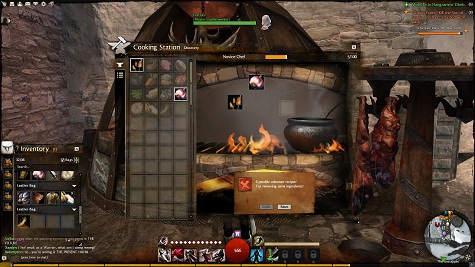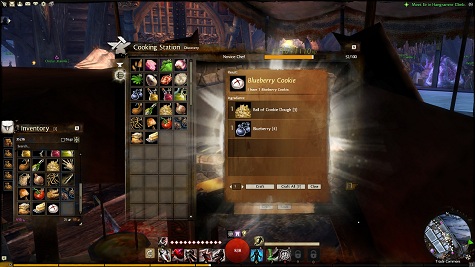B
Bella
Guest
Great article on crafting that I thought would be a nice update giving an idea of the overall process.
Thanks to Christina Gonzalez and MMORPG for sharing this article with the GW2 players!Guild Wars 2 General Article: Crafting Preview
By Christina Gonzalez on April 30, 2012
Let me start by saying that I really enjoy crafting in my MMOs. I feel like it adds an extra dimension to the game. I enjoy the feeling of self-sufficiency being able to craft gives me and hey, the ability to help my guildmates with stuff doesn’t hurt either. So, it was without hesitation that after creating my Norn Thief this past weekend in Guild Wars 2’s first beta weekend that I set off to find some skill trainers. Around level six or so, I made my way to Hoelbrak, the Norn city and signed up with the Cooking and Leatherworking disciplines. Since GW2 thieves use medium armor, Leatherworking seemed like a good idea and, as in many games, cooking seemed like it would be practical for my own needs, guildmates, and to put on the market.
Now crafting in Guild Wars 2 doesn’t break the mold, but it’s a generally solid, fluid system that has a couple of issues that aren’t dealbreakers. This is how the system generally works. You choose one of several disciplines—Weaponsmith, Armorsmith, Cook, Tailor, Artificer, Jeweler, Leatherworker, and Huntsman—and start out with some basic recipes. Your task is to create items and learn new recipes by which to continue learning how to make more items as you progress and level up through the game.
You’ll learn new recipes by a couple of different methods. The first is simply by crafting items that you find in your list of basic recipes that you earn simply via the experience points from crafting itself. You can also experiment with up to four ingredients of your choice and try to discover unknown recipes. The game will tell you how many unknown recipes exist with the combination of ingredients you’ve chosen and, depending on what you add there, might suggest adding another ingredient or telling you that there are no possible outcomes. If you do get a suggestion, however, it will also let you know the skill level of that recipe you may have stumbled upon.
If it’s possible to craft something and learn a new recipe from a combo you’ve tried, it’ll let you know by saying “That looks like something” and the indicator above that message will turn blue. Follow that and you won’t go wrong. Note that even if you have the proper series of ingredients for something, if it’s above your current skill level in your craft discipline, you won’t be able to even attempt it. There’s no try and no possibility of failing to craft something and burning your mats. If you stumble upon it under all the right circumstances, you’ll be able to make whatever you’ve put together.
The third way of finding recipes might be the most fun, at least to an explorer like me. NPCs are hanging out in the world and going about their business. I helped a guy out in the woods on the side of the road and was able to buy an eggs on toast recipe from him. One of the others I helped out also had a recipe for sale.
You earn XP for gathering resources and XP for crafting items in your recipe list. However, as you advance, item names appear color-coded according to their level and difficulty. Grayed-out recipes will provide only minimal XP, while blue ones will offer a bit more, and yellow recipe names are the current level ones.
Different disciplines can result in widely different gains from crafting to balance things out. For example, Cooking gives what seems like a lot of XP at first (I went from level 10 to level 11 pretty much just by gathering and crafting), but when you factor in that you have to gather or buy the materials, it makes more sense. My other profession was Leatherworker, and, in contrast, most of those materials are loot drops so there’s more XP in the gathering process overall. It balances out.
There were a couple of things about crafting that I hope ArenaNet will consider changing or adjusting. For one, it’s a bit slow going in the beginning. As someone that loves crafting, there’s a certain feeling that I should be able to at least try to make a recipe that’s technically above my level, even if I might fail.
As with all crafting systems, it’s a money and resource sink, but it’s a straightforward system. Gather some materials, loot others, combine, and voila. However, gathering can sometimes be a bit annoying and arbitrary. I was looking for onions to try out a particular recipe and, as a Norn, the first place I found onions was atop a snowy mountain next to a tough troll. I’m not expecting realism here, but when I took my Norn into the Human territory, she was able to find a lot of ingredients in more logical places, such as on farmland. It just seemed like the crops were harder to find in Nornland.
The distribution of materials also seems to want to keep pace with the player level, which is great, but compared to the freedom that the game gives you in general, it’s a bit odd that the same choice not be offered here. Being able to afford materials is sometimes an issue too, especially if you’re trying to do two crafting disciplines. You might want to throw your efforts behind one at a time to progress more steadily and to not fill up that valuable inventory and bank space. I had a friend generously offered money to me to try to advance in both of my crafting disciplines knowing that I was writing this. It’s important to note that purchasing ingredients and materials just to unlock both to 50 skill points took approximately 30 silver.
Once you’ve unlocked some new recipes at skill levels 5 and 50 is when things start to really pick up and get interesting. For me, I get hooked on trying to discover as many recipes as I can. While the mechanics here are nothing groundbreaking, it’s still a fun and satisfying system. My favorite crafting system just may be a tie between Lord of the Rings Online and The Matrix Online. In the former, you’re able to gather your materials, but in some cases grow or process the materials. The Matrix Online let you break down nearly all items in the game and, if successful, granted you the recipe. Guild Wars 2’s system falls somewhere in the middle for me. It’s fun; aiming to keep pace until 80 with you. Some of the unknown recipes had difficulty ratings over 300. It’s rewarding, in both XP and items, and once you get past the initial barrier to entry, welcomes you with open arms like so much in this game does.



